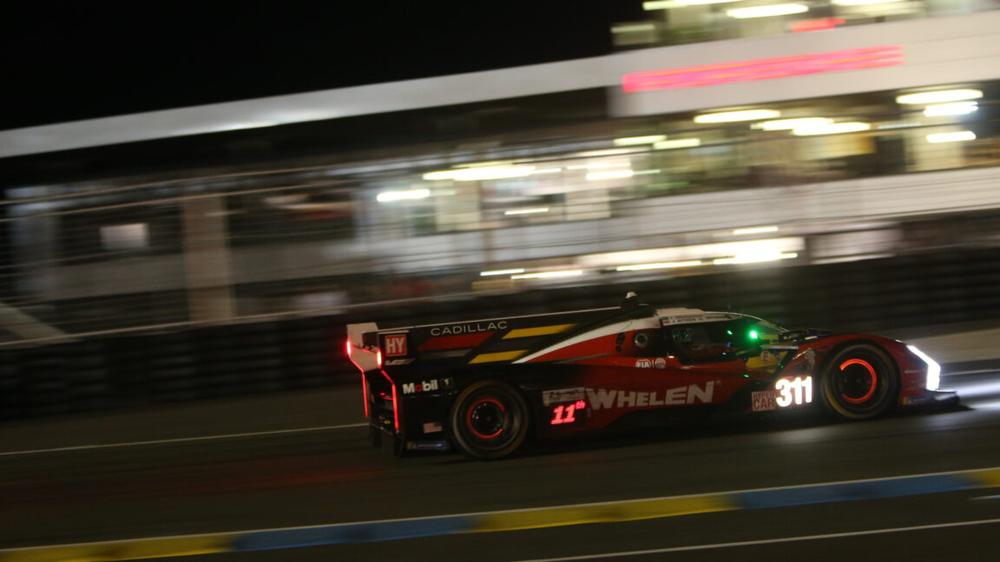LE MANS, FRANCE—It's 2 am at the Circuit de la Sarthe, just a few hours from Paris, France. The 24 Hours of Le Mans race is nearly halfway through, and fans are late-night snacking, snoozing in their sleeping bags, or pressed up against the fence to watch the cars zip by. The sound is thunderous as a batch of hypercars pass, each brand with a distinctive pattern of notes.
The real show after darkness falls is not the laser lights or drone formation but the sight of red-hot brake calipers glowing through the front wheels at the turns. Turn four, in particular, put on a display of fiery orange and red, visible to the naked eye.
For the first time, all 62 cars on the 2025 Le Mans starting grid were equipped with at least one component—including calipers, discs, and pads—made by a single manufacturer: Brembo. The glowing brakes are a result of high friction and high temperatures that start at 574˚ Fahrenheit (300˚ Celsius) and soar past the 1500˚ F (815˚ C) mark, and the components undergo extreme stress. Impressively, these systems are designed to endure through a whole race without changing a single element, despite Le Mans now being a 24-hour sprint race. (Mid-race brake changes were commonplace back when the cars were more fragile.)
A test bench for production car brakes
Brembo is based in Bergamo, Italy, about an hour from Milan. The headquarters are inside the Kilometro Rosso innovation district, marked by a long red wall easily visible from the top of Bergamo's historic district. Founded in 1961, Brembo established a relationship with Alfa Romeo early on with brake discs and later launched a successful partnership with the Ferrari racing team that remains active today.
It's easy to recognize Brembo's bright-red calipers from a distance. They scream for attention, and deservedly so, since they're often part of higher and more expensive trim packages for production cars. On World Endurance Championship and Formula 1 cars, the calipers may be painted different colors depending on the brand, but they work the same.
Brandon Miller, Brembo's sports car and GT market manager, says everything the company makes for the production manufacturing side was born in the racing world. It's a tough test bench; at Le Mans, drivers brake about once every 20 seconds. That equates to 4,000 braking events during the 24-hour race, and the carbon discs are required to perform perfectly every time, even in decelerations exceeding 124 mph (200 kmh).
Inside Brembo’s racing R&D headquarters
The entrance of Brembo's Bergamo factory is lined with long hallways featuring discs, pads, and calipers from throughout the company's history. There's even an eight-piston Bugatti Bolide caliper, designed not for racing but for performance and safety. These massive eight-piston calipers include four pads and three mounting points for the appropriate stopping power in the Bugatti, which is capable of speeds of up to 311 mph (500 km/h). In the back of the house, Brembo is focused on research and development. The secrets are held closely, and visitors cannot take photos or video except in specific areas.
We got to touch and observe the carbon disc materials, which feel like individual pieces of fabric. The layers are molded together for a lightweight disc capable of stopping racing cars at high speeds, lap after lap. Carbon discs are drilled with holes for thermal regulation, while cast-iron discs, which take a little longer to cool, are vaned for air flow.
"When we design the brake system with a manufacturer, they share their particular cooling requirements," Miller explained. "We conduct a study on our brake dynos, which gives us air volume to meet a specific cooling requirement to get the brakes operating in a specific range."
For the fastest racing cars, brake discs may be drilled with between 1,000 and 1,100 holes at the front and 900 at the rear. At Brembo HQ, the discs are drilled in a special case that collects the carbon dust particles and sucks them away from the machinery and safely away from any humans nearby.
"Ultimately, the more cooling holes, the lower the temperature of the disc," Miller said. "You have mechanical wear between the disc and the pad, and 350˚ Celsius and below you have a lot of dust, which physically wears the disc. At higher temperature ranges, the dust between the pad and the disc creates friction. That results in less wear and less impact."
The shift to technology
While manufacturing is the visible side of the brakes process, CEO Daniele Schillaci emphasizes the role of technology. In the last three years alone, Brembo has hired more than 100 software engineers in Italy, China, India, and the US (some in Silicon Valley).
"The automotive business is in a very deep transformation phase with new technology, software, AI, and electrification," Schillaci said. "Until a couple of years ago, Brembo was a very nice company building cast iron discs, aluminum calipers, and carbon ceramic for racing. But when it came to software, Brembo wasn't top of mind."
That's changing, as the manufacturer has poured money and resources into its newest offering, a software-controlled product called Sensify. Billed as the first fluid-free braking system that continuously controls and supervises each wheel's braking, Sensify integrates software and mechatronics, combining mechanical, electrical, computer, and robotics engineering with code.
Brembo sees Sensify as a significant breakthrough that represents a new standard in the automotive industry, and the company built the software and AI in-house. While some outlets are describing it as brake-by-wire technology, which debuted more than 20 years ago, Schillaci says it goes way beyond that.
"Sensify is more than brake-by-wire," Schillaci said. "Brembo has been collecting data from its test benches for many years. With this data, combined with our internally built algorithm, Brembo has increased its ability to read the data and understand the impulse in the braking system at each corner. The car will stay stable, without vibration, even in emergency braking situations."
As racing evolves, parts manufacturers will have to as well. Brembo, like the rest of the industry, aims to stay on top of the shift and use the latest tools to remain successful.

 The ModRetro Chromatic Game Boy is now permanently back in stock
The ModRetro Chromatic Game Boy is now permanently back in stock